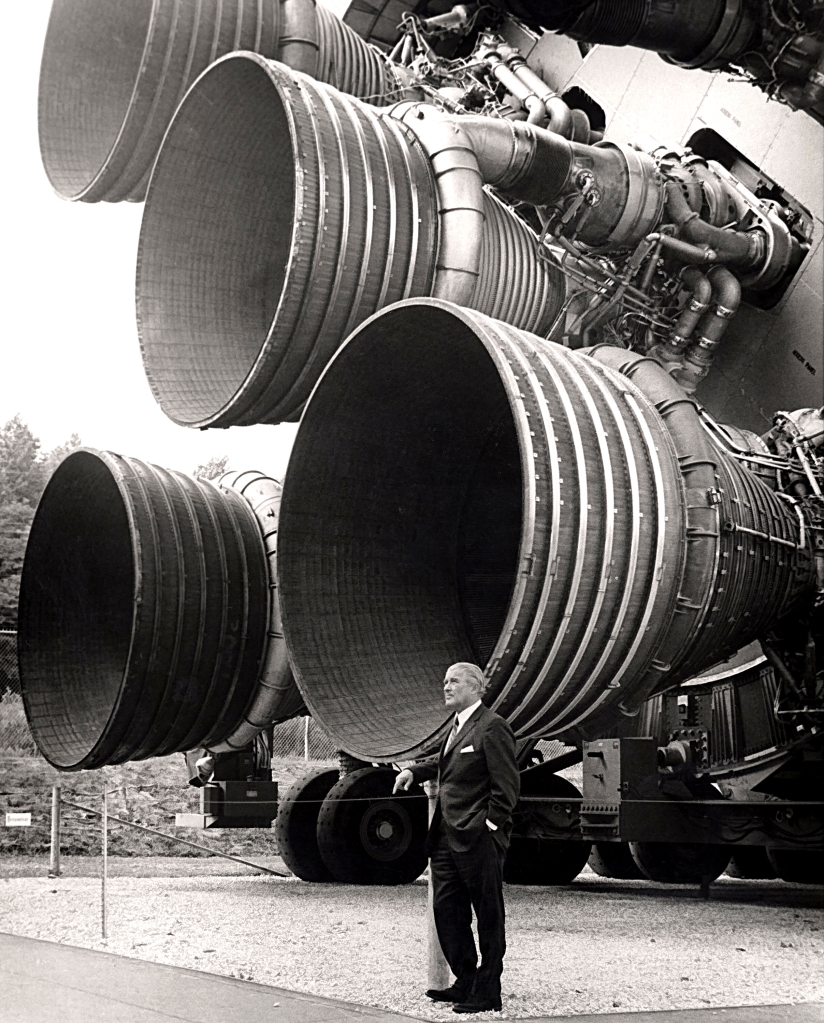I recently finished reading an excellent biography about Wernher von Braun. While browsing a used bookstore in Victoria, BC last year, I picked this book up on a whim. I really didn’t know anything at all about the man or his life, prior to this. In retrospect, I cannot believe I didn’t know anything, and I have to say I’m absolutely floored.
The book is Von Braun: Dreamer of Space, Engineer of War, by Michael J. Neufeld.

The title really does a great job of summarizing the theme of the book. Von Braun’s life was in many ways a dichotomy between, on the one hand, his lofty intentions, a fascination with rockets and plans to use them for spaceflight and travel to the moon and distant worlds, and on the other hand, the darker side of his achievements, which were the creation of a weapon of immense destruction and war.
Pre-1945: German background and the Nazi regime
Von Braun straddled two worlds in many different ways, both literally and metaphorically. He was born and raised in Germany, received an education as an engineer and became an extremely effective and capable leader in engineering management – that is, leading large, complex engineering projects and organizations involving hundreds or even thousands of people.
As the Nazi regime came to power, von Braun was gradually pulled into its orbit (or intentionally gravitated towards it, depending on your view). He saw that the military and government were a powerful source of funding for the research and development of rockets, and von Braun seized the opportunity.
At Peenemunde, he developed rockets for the Nazi regime, including the infamous V-2, the world’s first long-range guided ballistic missile. The Germans used the V-2 during World War II to attack Allied cities, as retribution for Allied bombings of German cities (thus the German name for the rocket, Vergeltungswaffe 2, meaning “Retribution Weapon 2”). The V-2 was also the first rocket to travel outside the earth’s atmosphere into space. The rocket von Braun brought to fruition was therefore used to bring destruction during the war, but also for pioneering spaceflight, a familiar duality in von Braun’s life.
Von Braun joined the Nazi party and even met Hitler on several occasions. He rose in the party’s ranks and became an SS officer. And yet he never seemed particularly enthusiastic or dedicated to the Nazi ideology or cause. It was clear that his only passion was rocketry, and the Nazi regime was willing to pour vast amounts of money into his organization at Peenemunde. At the same time, he never seems to have strongly objected to what the Nazis were doing, although he likely wasn’t aware of the full horrors of the Holocaust at that time. Years (and decades) after the war ended, von Braun condemned the regime, but of course that was much easier to do in retrospect and seems opportunistic.

Post-1945: Spaceflight program leadership in the United States
After World War II ended in 1945, von Braun emigrated to the United States, one of several dozen scientists brought over as part of “Operation Paperclip.” He settled with his wife in Huntsville, Alabama, and with many other German workers as part of his organization. Von Braun lived in Huntsville for the next twenty years, raising a family there, and working for the US Army. He played a lead role in developing the Redstone rocket, which was used for the first live nuclear ballistic missile tests for the US, as well as the Jupiter-C rocket, which launched the first US satellite, Explorer 1, in 1958 (although this was not the world’s first satellite, which was the USSR’s Sputnik 1, in 1957).
Von Braun may have been opportunistic, but he thoroughly embraced his new American identity and believed that the US should lead the “free world” in the space race against the Soviet Union.
He later joined the newly created NASA in 1960 and played a major role in historic NASA projects, including the Mercury Redstone, Gemini, and Apollo programs. He was dedicated to the success of the Apollo program, and under his leadership, Apollo had a flawless track record for safety and success. The Apollo 11 lunar landing – the achievement of seeing humans actually set foot on the moon in 1969 – was probably the highlight of his life.

This is of course only a summary of von Braun’s life, and in this summary I am doing him an enormous disservice. Beyond his engineering, technical, and management genius, von Braun also increasingly became a popular household name as he began appearing in Walt Disney-produced documentaries in the 1950s about the future of spaceflight, and man in space. These documentaries themselves are fascinating, in retrospect, and are the subject of an entire separate post I plan to write.
A controversial legacy
Von Braun was a lifelong spaceflight enthusiast and strongly advocated for putting humans into space and going to the moon. It is safe to say that he is one of the most important individuals of the twentieth century: he basically led the development of the liquid fuel rocket into a mature technology, and he was directly responsible for the success of NASA’s Apollo program, among other accomplishments. And yet his rockets also have the legacy of destruction. He is ultimately responsible for the development of intercontinental ballistic missiles (ICBMs) and the dangerous cloud of nuclear war that hung over the entire world for the latter half of the twentieth century, and continues to hang over us to this day.
Intriguingly, this is a man who was an SS officer in the Nazi party and built weapons for Adolf Hitler, and yet also joined the US government and obtained security clearances, rose in its ranks, and personally met with multiple presidents including Dwight Eisenhower, John F. Kennedy, and Lyndon Johnson.
I highly recommend this book for a thoughtful, balanced study of von Braun’s life in much more fascinating detail.
